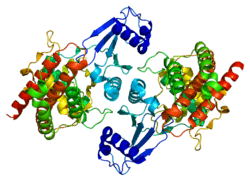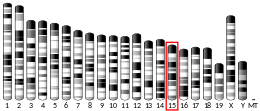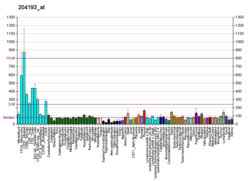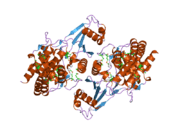CHKB (gene)
Choline kinase beta (CK), also known as Ethanolamine kinase (EK), Choline kinase-like protein , choline/ethanolamine kinase beta (CKEKB), or Choline/ethanolamine kinase is a protein encoded by the CHKB gene.[5][6] This gene is found on chromosome 22 in humans. The encoded protein plays a key role in phospholipid biosynthesis. Choline kinase (CK) and ethanolamine kinase (EK) catalyzes the first step in phosphatidylethanolamine biosynthesis. Read-through transcripts are expressed from this locus that include exons from the downstream CPT1B locus.[7][8][9]
Structure
The CHKB gene is located on the q arm of chromosome 22 at position 13.3 and it spans 4,041 base pairs.[7] The CHKB gene produces a 7 kDa protein composed of 60 amino acids.[10][11] The structure of the protein has been found to be a homodimer, and forms a heterodimer with the CHKA protein.[9][8] It has also been found to contain multiple highly conserved domains, such as a Brenner phosphotransferase consensus sequence essential in catalytic function.[12]
Function
The CHKB gene encodes for a key protein in phospholipid biosynthesis. The choline kinase (CK) and ethanolamine kinase (EK) proteins, which are coded by the CHKB gene, catalyze the phosphorylation of choline/ethanolamine in vitro to phosphocholine/phosphoethanolamine. The catalysis is controlled by ATP in the presence of magnesium and ADP, and commits choline to the enzymatic pathway for biosynthesis of phosphatidylcholine. This is the first step in the biosynthesis of phosphocholine/phosphoethanolamine in all animal cells, and is done by the Kennedy pathway. The highly purified choline kinases from mammalian sources and their recombinant gene products have been shown to have ethanolamine kinase activity as well, indicating that both activities reside on the same protein. However, it has been shown that the protein has higher activity with ethanolamine and may not significantly contribute to in vivo phosphatidylcholine biosynthesis. The choline kinase-like protein encoded by CHKB belongs to the choline/ethanolamine kinase family; however, its exact function is not known. At least two transcript variants encoding two different isoforms have been found for this gene, and one of the transcripts is bicistronic.[7][8][9][13][14]
Clinical significance
Mutations in CHKB have been found to result in mitochondrial deficiencies and associated disorders. Knockdown of the gene has been known to result in decreased choline kinase and phosphatidylcholine activity. This impairment in activity may lead to a modified composition of the phospholipid composition in the mitochondrial membrane resulting in major disorders in the function and structure of the mitochondria. Major disorders include as Megaconial Congenital Muscular Dystrophy (MDCMC), and Narcolepsy.[7][15]
Megaconial Congenital Muscular Dystrophy (MDCMC)
CHKB mutations have been majorly associated with Megaconial Congenital Muscular Dystrophy (MDCMC). Megaconial Congenital Muscular Dystrophy (MDCMC) is an autosomal recessive congenital muscular dystrophy characterized by muscle biopsy results displaying an enlarged mitochondria which are common in the periphery of the fibers but scarce around the center.[16]
Common clinical manifestations of MDCMC include:[15][17]
- early-onset hypotonia
- muscle wasting
- mildly elevated serum creatine kinase (CK) levels
- severe intellectual disability without brain structural abnormalities
- Gower's sign
- mental retardation
- fatal cardiomyopathy
Symptoms such as neurogenic atrophy, enlarged mitochondria in the periphery of the fibers, and complex I deficiency were shown in a Spanish patient with a homozygous mutation of c.810T>A.[15] Another patient with a homozygous mutation (p.E292X) in the CHKB gene exhibited rhythmic jerkings of arms, which were characterized as muscle spasms.[14] Finally, a patient with a homozygous c.810T>A showed signs of Gower's sign, hypotonia, and proximal muscle weakness.[18]
Narcolepsy
Narcolepsy is a neurological disabling sleep disorder, characterized by excessive daytime sleepiness, sleep fragmentation, symptoms of abnormal rapid-eye-movement (REM) sleep, cataplexy, hypnagogic hallucinations, and sleep paralysis. Cataplexy is a sudden loss of muscle tone triggered by emotions, which is the most valuable clinical feature used to diagnose narcolepsy. Human narcolepsy is primarily a sporadically occurring disorder but familial clustering has been observed.[19]
Interactions
CHKB has been shown to have Protein-protein interactions with the following.[20][8]
References
- GRCh38: Ensembl release 89: ENSG00000100288 - Ensembl, May 2017
- GRCm38: Ensembl release 89: ENSMUSG00000022617 - Ensembl, May 2017
- "Human PubMed Reference:". National Center for Biotechnology Information, U.S. National Library of Medicine.
- "Mouse PubMed Reference:". National Center for Biotechnology Information, U.S. National Library of Medicine.
- Yamazaki N, Yamanaka Y, Hashimoto Y, Shinohara Y, Shima A, Terada H (June 1997). "Structural features of the gene encoding human muscle type carnitine palmitoyltransferase I". FEBS Lett. 409 (3): 401–6. doi:10.1016/S0014-5793(97)00561-9. PMID 9224698.
- Aoyama C, Liao H, Ishidate K (May 2004). "Structure and function of choline kinase isoforms in mammalian cells". Prog. Lipid Res. 43 (3): 266–81. doi:10.1016/j.plipres.2003.12.001. PMID 15003397.
-
"Entrez Gene: CHKB choline kinase beta".

-
"CHKB - Choline/ethanolamine kinase - Homo sapiens (Human) - CHKB gene & protein". Retrieved 2018-08-23.

- "UniProt: the universal protein knowledgebase". Nucleic Acids Research. 45 (D1): D158–D169. January 2017. doi:10.1093/nar/gkw1099. PMC 5210571. PMID 27899622.
- Zong NC, Li H, Li H, Lam MP, Jimenez RC, Kim CS, Deng N, Kim AK, Choi JH, Zelaya I, Liem D, Meyer D, Odeberg J, Fang C, Lu HJ, Xu T, Weiss J, Duan H, Uhlen M, Yates JR, Apweiler R, Ge J, Hermjakob H, Ping P (Oct 2013). "Integration of cardiac proteome biology and medicine by a specialized knowledgebase". Circulation Research. 113 (9): 1043–53. doi:10.1161/CIRCRESAHA.113.301151. PMC 4076475. PMID 23965338.
- "Protein CHKB-CPT1B". Cardiac Organellar Protein Atlas Knowledgebase (COPaKB). Archived from the original on 2018-08-24. Retrieved 2018-08-23.
- Aoyama C, Yamazaki N, Terada H, Ishidate K (2000). "Structure and characterization of the genes for murine choline/ethanolamine kinase isozymes alpha and beta". J. Lipid Res. 41 (3): 452–64. PMID 10706593.
- Ishidate K (1997). "Choline/ethanolamine kinase from mammalian tissues". Biochim. Biophys. Acta. 1348 (1–2): 70–8. doi:10.1016/s0005-2760(97)00118-5. PMID 9370318.
- Gutiérrez Ríos, P; Kalra, AA; Wilson, JD; Tanji, K; Akman, HO; Area Gómez, E; Schon, EA; DiMauro, S (May 2012). "Congenital megaconial myopathy due to a novel defect in the choline kinase Beta gene". Archives of Neurology. 69 (5): 657–61. doi:10.1001/archneurol.2011.2333. PMID 22782513.
- Castro-Gago, M; Dacruz-Alvarez, D; Pintos-Martínez, E; Beiras-Iglesias, A; Arenas, J; Martín, MÁ; Martínez-Azorín, F (January 2016). "Congenital neurogenic muscular atrophy in megaconial myopathy due to a mutation in CHKB gene". Brain & Development. 38 (1): 167–72. doi:10.1016/j.braindev.2015.05.008. PMID 26006750.
- Mitsuhashi, S; Ohkuma, A; Talim, B; Karahashi, M; Koumura, T; Aoyama, C; Kurihara, M; Quinlivan, R; Sewry, C; Mitsuhashi, H; Goto, K; Koksal, B; Kale, G; Ikeda, K; Taguchi, R; Noguchi, S; Hayashi, YK; Nonaka, I; Sher, RB; Sugimoto, H; Nakagawa, Y; Cox, GA; Topaloglu, H; Nishino, I (10 June 2011). "A congenital muscular dystrophy with mitochondrial structural abnormalities caused by defective de novo phosphatidylcholine biosynthesis". American Journal of Human Genetics. 88 (6): 845–851. doi:10.1016/j.ajhg.2011.05.010. PMC 3113344. PMID 21665002.
- "Muscular dystrophy, congenital, megaconial type Genetic and Rare Diseases Information Center (GARD) – an NCATS Program". Rarediseases.info.nih.gov.
- Nishino, I; Kobayashi, O; Goto, Y; Kurihara, M; Kumagai, K; Fujita, T; Hashimoto, K; Horai, S; Nonaka, I (January 1998). "A new congenital muscular dystrophy with mitochondrial structural abnormalities". Muscle & Nerve. 21 (1): 40–7. doi:10.1002/(SICI)1097-4598(199801)21:1<40::AID-MUS6>3.0.CO;2-G. PMID 9427222.
- "Narcolepsy 7". www.uniprot.org.
- Mick DU, Dennerlein S, Wiese H, Reinhold R, Pacheu-Grau D, Lorenzi I, Sasarman F, Weraarpachai W, Shoubridge EA, Warscheid B, Rehling P (December 2012). "MITRAC links mitochondrial protein translocation to respiratory-chain assembly and translational regulation". Cell. 151 (7): 1528–41. doi:10.1016/j.cell.2012.11.053. PMID 23260140.
External links
- Human CHKB genome location and CHKB gene details page in the UCSC Genome Browser.
- Human CKB genome location and CKB gene details page in the UCSC Genome Browser.
Further reading
- Aoyama C, Liao H, Ishidate K (2004). "Structure and function of choline kinase isoforms in mammalian cells". Prog. Lipid Res. 43 (3): 266–81. doi:10.1016/j.plipres.2003.12.001. PMID 15003397.
- Gerhard DS, Wagner L, Feingold EA, et al. (2004). "The status, quality, and expansion of the NIH full-length cDNA project: the Mammalian Gene Collection (MGC)". Genome Res. 14 (10B): 2121–7. doi:10.1101/gr.2596504. PMC 528928. PMID 15489334.
- Collins JE, Wright CL, Edwards CA, et al. (2005). "A genome annotation-driven approach to cloning the human ORFeome". Genome Biol. 5 (10): R84. doi:10.1186/gb-2004-5-10-r84. PMC 545604. PMID 15461802.
- Ota T, Suzuki Y, Nishikawa T, et al. (2004). "Complete sequencing and characterization of 21,243 full-length human cDNAs". Nat. Genet. 36 (1): 40–5. doi:10.1038/ng1285. PMID 14702039.
- Strausberg RL, Feingold EA, Grouse LH, et al. (2003). "Generation and initial analysis of more than 15,000 full-length human and mouse cDNA sequences". Proc. Natl. Acad. Sci. U.S.A. 99 (26): 16899–903. doi:10.1073/pnas.242603899. PMC 139241. PMID 12477932.
- Hirosawa M, Nagase T, Murahashi Y, et al. (2001). "Identification of novel transcribed sequences on human chromosome 22 by expressed sequence tag mapping". DNA Res. 8 (1): 1–9. doi:10.1093/dnares/8.1.1. PMID 11258795.
- Yamazaki N, Shinohara Y, Kajimoto K, et al. (2000). "Novel expression of equivocal messages containing both regions of choline/ethanolamine kinase and muscle type carnitine palmitoyltransferase I". J. Biol. Chem. 275 (41): 31739–46. doi:10.1074/jbc.M006322200. PMID 10918069.
- Loftus BJ, Kim UJ, Sneddon VP, et al. (1999). "Genome duplications and other features in 12 Mb of DNA sequence from human chromosome 16p and 16q". Genomics. 60 (3): 295–308. doi:10.1006/geno.1999.5927. PMID 10493829.
- Aoyama C, Nakashima K, Matsui M, Ishidate K (1998). "Complementary DNA sequence for a 42 kDa rat kidney choline/ethanolamine kinase". Biochim. Biophys. Acta. 1390 (1): 1–7. doi:10.1016/s0005-2760(97)00177-x. PMID 9487136.
- Yamazaki N, Yamanaka Y, Hashimoto Y, et al. (1997). "Structural features of the gene encoding human muscle type carnitine palmitoyltransferase I". FEBS Lett. 409 (3): 401–6. doi:10.1016/S0014-5793(97)00561-9. PMID 9224698.
This article incorporates text from the United States National Library of Medicine, which is in the public domain.






